A Study on the Gamma Radiation Protection Effectiveness of Nano/Micro-MgO-Reinforced Novel Silicon Rubber for Medical Applications
Abstract
:1. Introduction
2. Materials and Methods
3. Results and Discussions
3.1. EDX and TEM Results
3.2. Shielding Results
4. Conclusions
Author Contributions
Funding
Institutional Review Board Statement
Informed Consent Statement
Data Availability Statement
Acknowledgments
Conflicts of Interest
References
- Chanthima, N.; Kaewkhao, J.; Limkitjaroenporn, P.; Tuscharoen, S.; Kothan, S.; Tungjai, M.; Kaewjaeng, S.; Sarachai, S.; Limsuwan, P. Development of BaO-ZnO-B2O3 Glasses as a Radiation Shielding Material. Radiat. Phys. Chem. 2017, 137, 72–77. [Google Scholar] [CrossRef]
- Dong, M.; Zhou, S.; Xue, X.; Feng, X.; Yang, H.; Sayyed, M.; Tishkevich, D.; Trukhanov, A.; Almousa, N. Upcycling of Boron Bearing Blast Furnace Slag as Highly Cost-Effective Shield for Protection of Neutron Radiation Hazard: An Innovative Way and Proposal of Shielding Mechanism. J. Clean. Prod. 2022, 355, 131817. [Google Scholar] [CrossRef]
- Dong, M.; Xue, X.; Yang, H.; Li, Z. Highly Cost-Effective Shielding Composite Made from Vanadium Slag and Boron-Rich Slag and its Properties. Radiat. Phys. Chem. 2017, 141, 239–244. [Google Scholar] [CrossRef]
- Kaewjang, S.; Maghanemi, U.; Kothan, S.; Kim, H.J.; Limkitjaroenporn, P.; Kaewkhao, J. New Gadolinium Based Glasses for Gamma-Rays Shielding Materials. Nucl. Eng. Des. 2014, 280, 21–26. [Google Scholar] [CrossRef]
- Rajesh, M.; Kavaz, E.; Borelli, D.P.R. Photoluminescence, Radiative Shielding Properties of Sm3+ Ions Doped Fluoroborosilicate Glasses for Visible (Reddish-Orange) Display and Radiation Shielding Applications. Mater. Res. Bull. 2021, 142, 111383. [Google Scholar] [CrossRef]
- Dong, M.; Zhou, S.; Xue, X.; Feng, X.; Sayyed, M.I.; Khandaker, M.U.; Bradley, D.A. The Potential Use of Boron Containing Resources for Protection Against Nuclear Radiation. Radiat. Phys. Chem. 2021, 188, 109601. [Google Scholar] [CrossRef]
- Dong, M.; Zhou, S.; Xue, X.; Sayyed, M.I.; Tishkevich, D.; Trukhanov, A.; Wang, C. Study of Comprehensive Shielding Behaviors of Chambersite Deposit for Neutron and Gamma Ray. Prog. Nucl. Energy 2022, 146, 104155. [Google Scholar] [CrossRef]
- Abbas, M.I.; El-Khatib, A.M.; Dib, M.F.; Ezzelddin Mustafa, H.; Sayyed, M.I.; Elsafi, M. The Influence of Bi2O3 Nanoparticle Content on the γ-ray Interaction Parameters of Silicon Rubber. Polymers 2022, 14, 1048. [Google Scholar] [CrossRef]
- Sankaran, S.; Deshmukh, K.; Ahamed, M.B.; Pasha, S.K. Recent Advances in Electromagnetic Interference Shielding Properties of Metal and Carbon Filler Reinforced Flexible Polymer Composites: A Review. Compos. Part A Appl. Sci. Manuf. 2018, 114, 49–71. [Google Scholar] [CrossRef]
- Bhosale, R.; More, C.; Gaikwad, D.; Pawar, P.; Rode, M. Radiation Shielding and Gamma Ray Attenuation Properties of Some Polymers. Nucl. Technol. Radiat. Prot. 2017, 32, 288–293. [Google Scholar] [CrossRef]
- Almurayshid, M.; Alsagabi, S.; Alssalim, Y.; Alotaibi, Z.; Almsalam, R. Feasibility of Polymer-Based Composite Materials as Radiation Shield. Radiat. Phys. Chem. 2021, 183, 109425. [Google Scholar] [CrossRef]
- Turhan, M.F.; Akman, F.; Polat, H.; Kaçal, M.R.; Demirkol, I. Gamma-Ray Attenuation Behaviors of Hematite Doped Polymer Composites. Prog. Nucl. Energy 2020, 129, 103504. [Google Scholar] [CrossRef]
- Gilys, L.; Griškonis, E.; Griškevičius, P.; Adliene, D. Lead Free Multilayered Polymer Composites for Radiation Shielding. Polymers 2022, 14, 1696. [Google Scholar] [CrossRef] [PubMed]
- Nagaraja, N.; Sridhar, K.N.; Manjunatha, H.C.; Vidya, Y.S.; Seenappa, L.; Damodara Gupta, P.S.; Ramalingam, H.B. Measurement of Mass Attenuation Coefficient and its Derivable in Polymers. Prog. Nucl. Energy 2022, 144, 104044. [Google Scholar] [CrossRef]
- Ambika, M.R.; Nagaiah, N.; Harish, V.; Lokanath, N.K.; Sridhar, M.A.; Renukappa, N.M.; Suman, S.K. Preparation and Characterisation of Isophthalic-Bi2O3 Polymer Composite Gamma Radiation Shields. Radiat. Phys. Chem. 2017, 130, 351–358. [Google Scholar] [CrossRef]
- Nagaraja, N.; Manjunatha, H.; Seenappa, L.; Sridhar, K.; Ramalingam, H. Radiation Shielding Properties of Silicon Polymers. Radiat. Phys. Chem. 2020, 171, 108723. [Google Scholar] [CrossRef]
- Li, R.; Gu, Y.; Zhang, G.; Yang, Z.; Li, M.; Zhang, Z. Radiation Shielding Property of Structural Polymer Composite: Continuous Basalt Fiber Reinforced Epoxy Matrix Composite Containing Erbium Oxide. Compos. Sci. Technol. 2017, 143, 67–74. [Google Scholar] [CrossRef]
- Kaewjaeng, S.; Kothan, S.; Chaiphaksa, W.; Chanthima, N.; Rajaramakrishna, R.; Kim, H.J.; Kaewkhao, J. High Transparency La2O3-CaO-B2O3-SiO2 Glass for Diagnosis X-Rays Shielding Material Application. Radiat. Phys. Chem. 2019, 160, 41–47. [Google Scholar] [CrossRef]
- Kavaz, E.; Ghanim, E.H.; Abouhaswa, A.S. Optical, Structural and Nuclear Radiation Security Properties of Newly Fabricated V2O5-SrO-PbO Glass System. J. Non Cryst. Solids 2020, 538, 120045. [Google Scholar] [CrossRef]
- Kaewjaeng, S.; Chanthima, N.; Thongdang, J.; Reungsri, S.; Kothan, S.; Kaewkhao, J. Synthesis and Radiation Properties of Li2O-BaO-Bi2O3-P2O5 Glasses. Mater. Today Proc. 2021, 43, 2544–2553. [Google Scholar] [CrossRef]
- Şakar, E.; Büyükyıldız, M.; Alım, B.; Şakar, B.C.; Kurudirek, M. Leaded Brass Alloys for Gamma-Ray Shielding Applications. Radiat. Phys. Chem. 2019, 159, 64–69. [Google Scholar] [CrossRef]
- Aygün, B. High alloyed new stainless steel shielding material for gamma and fast neutron radiation. Nucl. Eng. Technol. 2019, 52, 647–653. [Google Scholar] [CrossRef]
- Dong, M.; Xue, X.; Yang, H.; Liu, D.; Wang, C.; Li, Z. A Novel Comprehensive Utilization of Vanadium Slag: As Gamma Ray Shielding Material. J. Hazard. Mater. 2016, 318, 751–757. [Google Scholar] [CrossRef]
- Abouhaswa, A.S.; Kavaz, E. A Novel B2O3-Na2O-BaO-HgO Glass System: Synthesis, Physical, Optical and Nuclear Shielding Features. Ceram. Int. 2020, 46, 16166–16177. [Google Scholar] [CrossRef]
- Mhareb, M.H.A. Physical, Optical and Shielding Features of Li2O-B2O3-MgO-Er2O3 Glasses Co-Doped of Sm2O3. Appl. Phys. A 2020, 126, 71. [Google Scholar] [CrossRef]
- Alajerami, Y.; Drabold, D.; Mhareb, M.; Cimatu, K.L.A.; Chen, G.; Kurudirek, M. Radiation Shielding Properties of Bismuth Borate Glasses Doped with Different Concentrations of Cadmium Oxides. Ceram. Int. 2020, 46, 12718–12726. [Google Scholar] [CrossRef]
- Araz, A.; Kavaz, E.; Durak, R. Neutron and Photon Shielding Competences of Aluminum Open-Cell Foams Filled with Different Epoxy Mixtures: An Experimental Study. Radiat. Phys. Chem. 2021, 182, 109382. [Google Scholar] [CrossRef]
- Cheewasukhanont, W.; Limkitjaroenporn, P.; Kothan, S.; Kedkaew, C.; Kaewkhao, J. The Effect of Particle Size on Radiation Shielding Properties for Bismuth Borosilicate Glass. Radiat. Phys. Chem. 2020, 172, 108791. [Google Scholar] [CrossRef]
- Akyildirim, H.; Kavaz, E.; El-Agawany, F.; Yousef, E.; Rammah, Y. Radiation Shielding Features of Zirconolite Silicate Glasses Using XCOM and FLUKA Simulation Code. J. Non Cryst. Solids 2020, 545, 120245. [Google Scholar] [CrossRef]
- Al-Hadeethi, Y.; Tijani, S.A. The use of lead-free transparent 50BaO-(50-x) borosilicate-xBi2O3 glass system as radiation shields in nuclear medicine. J. Alloy. Compd. 2019, 803, 625–630. [Google Scholar] [CrossRef]
- Aloraini, D.A.; Almuqrin, A.H.; Sayyed, M.I.; Al-Ghamdi, H.; Kumar, A.; Elsafi, M. Experimental Investigation of Radiation Shielding Competence of Bi2O3-CaO-K2O-Na2O-P2O5 Glass Systems. Materials 2021, 14, 5061. [Google Scholar] [CrossRef] [PubMed]
- Elsafi, M.; Alrashedi, M.; Sayyed, M.; Al-Hamarneh, I.; El-Nahal, M.; El-Khatib, M.; Khandaker, M.; Osman, H.; Askary, A. The Potentials of Egyptian and Indian Granites for Protection of Ionizing Radiation. Materials 2021, 14, 3928. [Google Scholar] [CrossRef] [PubMed]
- Al-Harbi, N.; Sayyed, M.I.; Al-Hadeethi, Y.; Kumar, A.; Elsafi, M.; Mahmoud, K.A.; Khandaker, M.U.; Bradley, D.A. A Novel CaO-K2O-Na2O-P2O5 Glass Systems for Radiation Shielding Applications. Radiat. Phys. Chem. 2021, 188, 109645. [Google Scholar] [CrossRef]
- Mhareb, M.H.A.; Zeama, M.; Elsafi, M.; Alajerami, Y.S.; Sayyed, M.I.; Saleh, G.; Hamad, R.M.; Hamad, M.K. Radiation Shielding Features for Various Tellurium-Based Alloys: A Comparative Study. J. Mater. Sci. Mater. Electron. 2021, 32, 26798–26811. [Google Scholar] [CrossRef]
- Kamislioglu, M. An Investigation into Gamma Radiation Shielding Parameters of the (Al:Si) and (Al+Na):Si-Doped International Simple Glasses (ISG) used in Nuclear Waste Management, Deploying Phy-X/PSD and SRIM Software. J. Mater. Sci. Mater. Electron. 2021, 32, 12690–12704. [Google Scholar] [CrossRef]
- Yasaka, P.; Pattanaboonmee, N.; Kim, H.J.; Limkitjaroenporn, P.; Kaewkhao, J. Gamma Radiation Shielding and Optical Properties Measurements of Zinc Bismuth Borate Glasses. Ann. Nucl. Energy 2014, 68, 4–9. [Google Scholar] [CrossRef]
- Kamislioglu, M. Research on the Effects of Bismuth Borate Glass System on Nuclear Radiation Shielding Parameters. Result Phys. 2021, 22, 103844. [Google Scholar] [CrossRef]
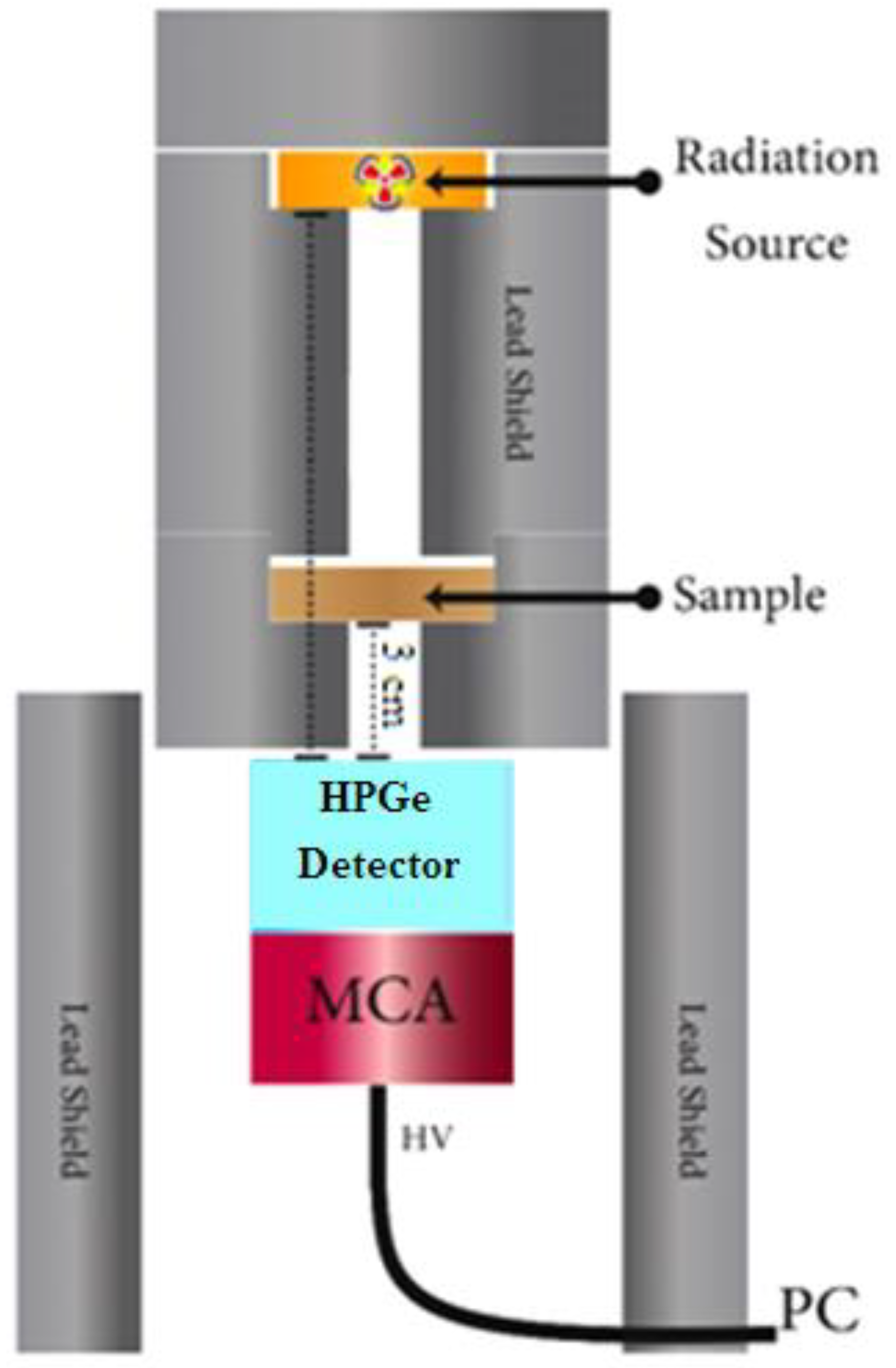


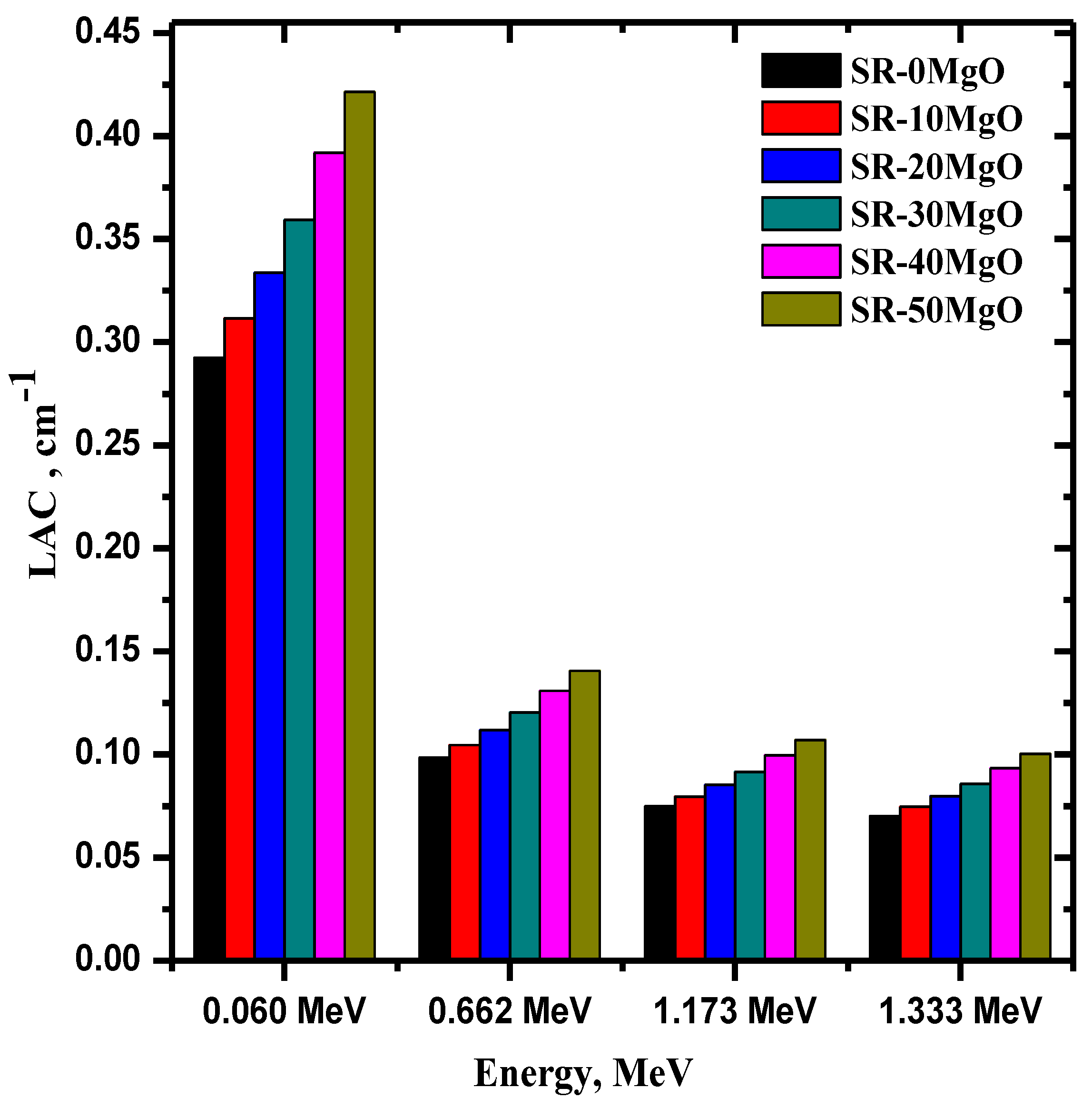


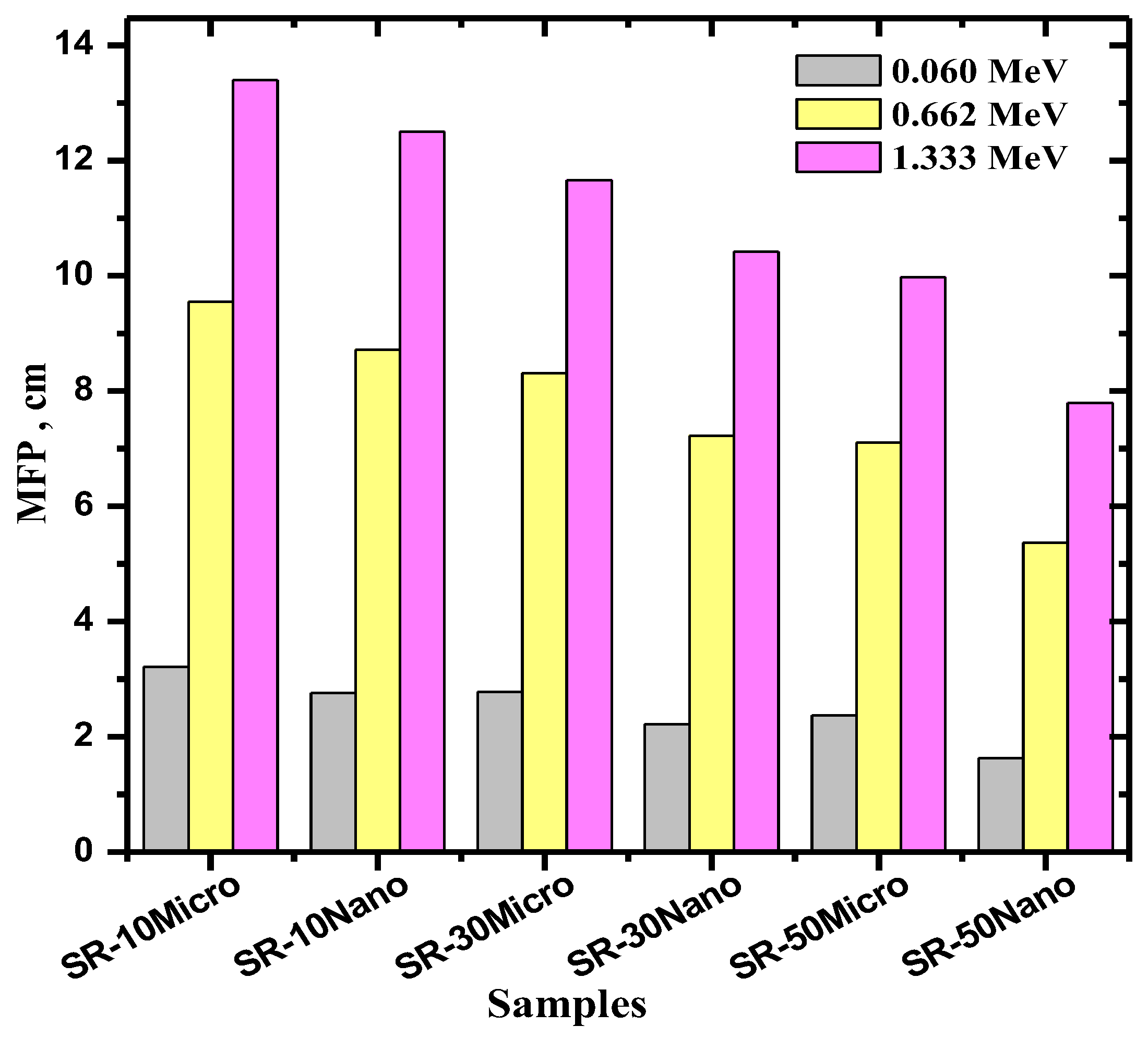
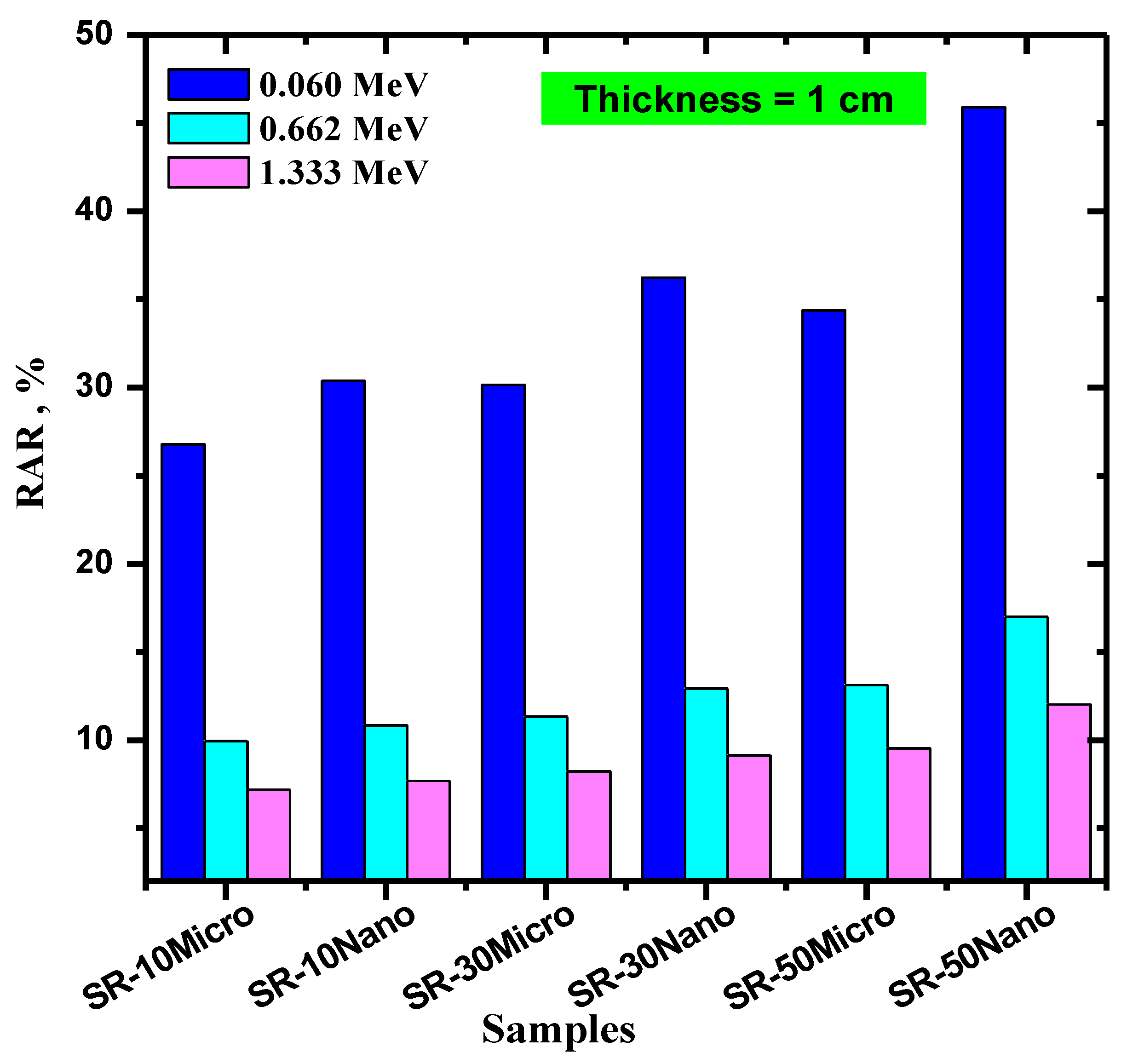
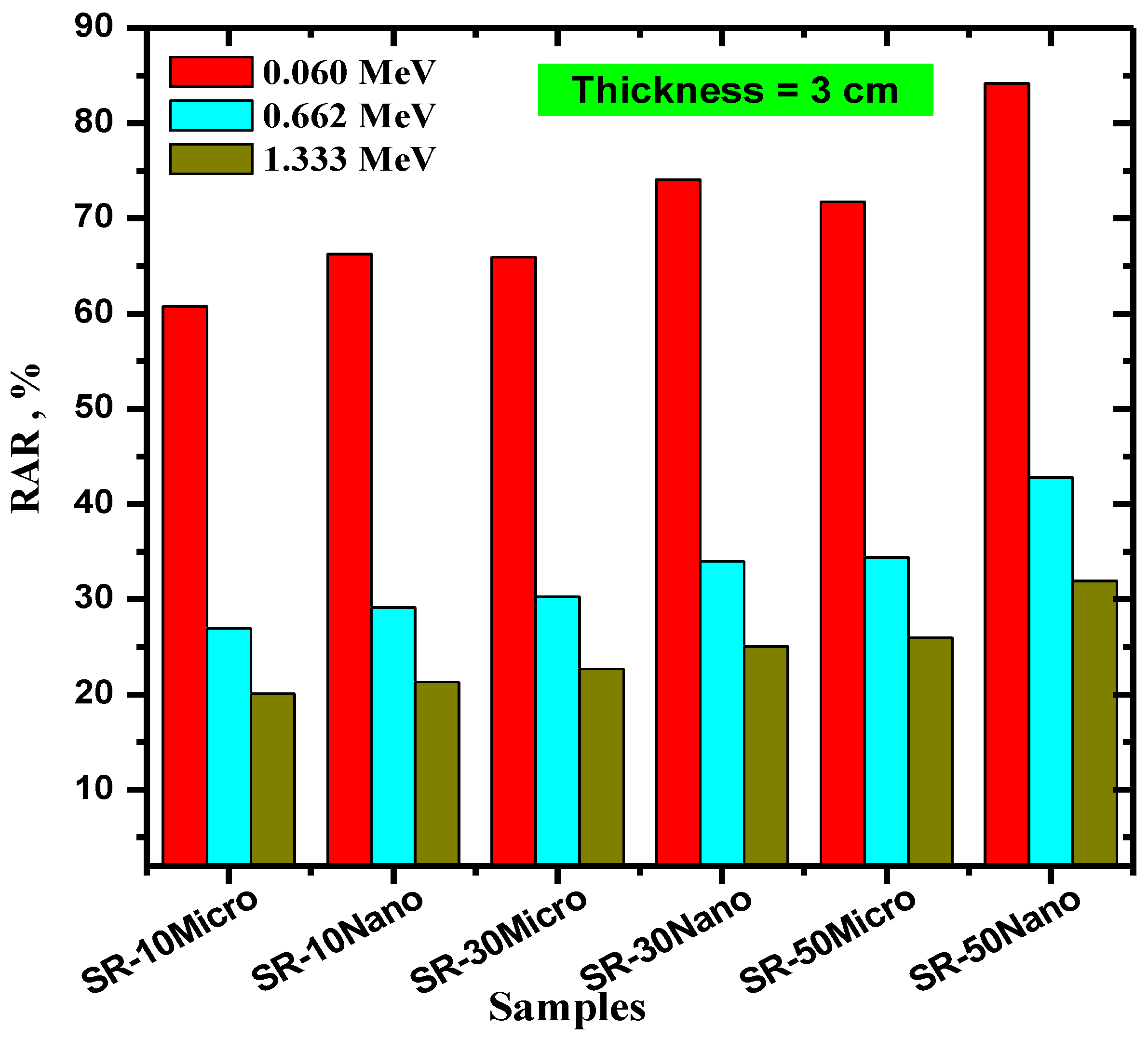
| Codes | Compositions (wt%) | Density (g × cm−3) | ||
|---|---|---|---|---|
| SR | MgO | |||
| Micro | Nano | |||
| SR-0MgO | 100 | - | 1.180 ± 0.008 | |
| SR-10mMgO | 90 | 10 | - | 1.264 ± 0.007 |
| SR-10nMgO | 90 | - | 10 | 1.268 ± 0.011 |
| SR-20mMgO | 80 | 20 | - | 1.361 ± 0.009 |
| SR-30mMgO | 70 | 30 | - | 1.469 ± 0.006 |
| SR-30nMgO | 70 | - | 30 | 1.479 ± 0.006 |
| SR-40mMgO | 60 | 40 | - | 1.621 ± 0.007 |
| SR-50mMgO | 50 | 50 | - | 1.754 ± 0.008 |
| SR-50nMgO | 50 | - | 50 | 1.760 ± 0.004 |
Publisher’s Note: MDPI stays neutral with regard to jurisdictional claims in published maps and institutional affiliations. |
© 2022 by the authors. Licensee MDPI, Basel, Switzerland. This article is an open access article distributed under the terms and conditions of the Creative Commons Attribution (CC BY) license (https://creativecommons.org/licenses/by/4.0/).
Share and Cite
Sayyed, M.I.; Al-Ghamdi, H.; Almuqrin, A.H.; Yasmin, S.; Elsafi, M. A Study on the Gamma Radiation Protection Effectiveness of Nano/Micro-MgO-Reinforced Novel Silicon Rubber for Medical Applications. Polymers 2022, 14, 2867. https://doi.org/10.3390/polym14142867
Sayyed MI, Al-Ghamdi H, Almuqrin AH, Yasmin S, Elsafi M. A Study on the Gamma Radiation Protection Effectiveness of Nano/Micro-MgO-Reinforced Novel Silicon Rubber for Medical Applications. Polymers. 2022; 14(14):2867. https://doi.org/10.3390/polym14142867
Chicago/Turabian StyleSayyed, M. I., Hanan Al-Ghamdi, Aljawhara H. Almuqrin, Sabina Yasmin, and Mohamed Elsafi. 2022. "A Study on the Gamma Radiation Protection Effectiveness of Nano/Micro-MgO-Reinforced Novel Silicon Rubber for Medical Applications" Polymers 14, no. 14: 2867. https://doi.org/10.3390/polym14142867
APA StyleSayyed, M. I., Al-Ghamdi, H., Almuqrin, A. H., Yasmin, S., & Elsafi, M. (2022). A Study on the Gamma Radiation Protection Effectiveness of Nano/Micro-MgO-Reinforced Novel Silicon Rubber for Medical Applications. Polymers, 14(14), 2867. https://doi.org/10.3390/polym14142867








